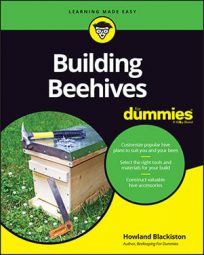That’s why it's recommend that you apply some kind of protection to all exterior wooden surfaces. Protecting your woodenware with exterior grade paint, weatherproof polyurethane, or marine varnish not only looks nice but also adds many seasons of life to your wooden beehives and equipment.
Here are some options for protecting the exterior of hives:
-
Most beekeepers paint their hives using a good quality exterior paint. Either latex or oil-based paints are fine. Many find semi-gloss paints easier to keep clean than matte. As to color, it really doesn’t matter — it’s up to you.
White is the most traditional color used in the United States, but in other countries, the sky’s the limit. Like your own house, you’ll need to repaint the hive every few years if you want it looking fresh (lest your nosy butterfly neighbors rat you out to the insect HOA.)
Keep in mind that really dark colors heat up more than light colors. Dark hives may be fine in the cold of winter but can quickly overheat the colony in the dog days of summer. So avoid black, navy blue, and aubergine!
-
Another approach is to polyurethane your woodenware. You can even stain the wood first if you want to. This is an attractive, natural-looking alternative to paint. In fact, this approach not only protects the wood but also tends to help the hive blend in better with the environment (which can be helpful if you don’t want to draw attention to your hives).
Be sure to use exterior grade polyurethane; gloss, semi-gloss, or satin is fine. Many prefer oil-based polyurethanes because they tend to stand up better to the elements. The resulting finish isn’t very flexible and may crack over time and require touching up.
-
Alternatively, you can apply several coats of marine-grade (spar) varnish to your woodenware. Again, you could stain the wood first if you want to. Spar varnish dries slower but is more flexible than polyurethane. Its flexibility means it tends not to crack. However, it must be reapplied periodically as it does tend to chip and flake off over time.
All the interior parts of the hive are best left untreated — no paint, no stain, no polyurethane, and no varnish. Keep the interior (where the bees live) au naturel. Doing so is healthier for the bees, and the bees prefer the natural living conditions because they’re more like the inside of a tree, where bees live in nature. Think of it as "Scandinavian-inspired minimalism" if you're going from an interior design angle.
Your hives and accessories undergo a good deal of stress over the seasons from weather conditions and from you frequently opening and closing the hives, moving the hives, swapping hive bodies, harvesting honey, and on and on. The goal is to build strong assemblies that stand the test of time. You can these little extra steps to ensure the wooden parts hold together for a long, long time.Lastly, remember to always use a good-quality, weatherproof wood glue in addition to nail and screw fasteners. Though gluing isn’t absolutely necessary, your joinery will have a better chance of long-term survival if you take the time to apply a thin coat of weatherproof wood glue before screwing or nailing wooden parts together. Your bees will thank you for it!

